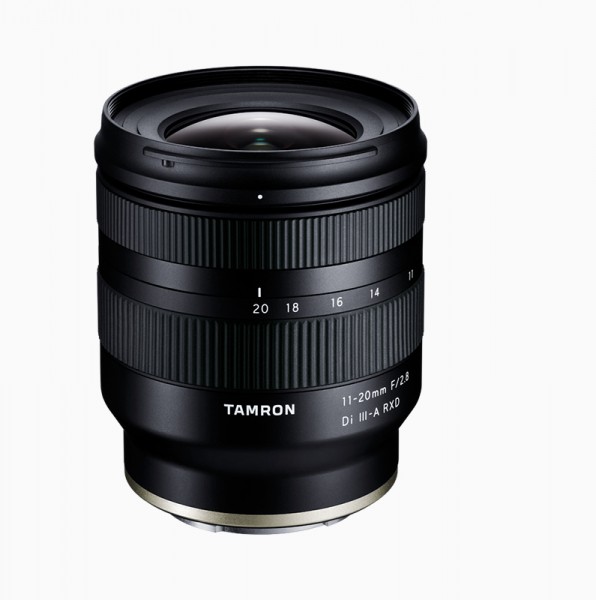Prices incl. VAT plus shipping costs
Delivery time 60 Workdays
The article can be wrapped as gift. You can choose from various wrapping options.
Top novelty
The new 11-20mm F/2.8 is the world's first ultra-wide-angle zoom lens for mirrorless APS-C cameras with Sony E-mount to feature a continuous aperture of F/2.8. Despite its large open aperture, it is very handy and forms a perfectly balanced unit in combination with a compact system camera. This makes it the ideal wide-angle lens for everyday use. Adding to the versatility of the new lens are its impressive close-up shooting capabilities. With a focal length of 11 mm, the shortest focusing distance is only 0.15 m, resulting in a maximum magnification of 1:4. This allows for impressive close-ups with a dramatic gradation of scale that only extreme wide-angle focal lengths can achieve.
The 11-20mm F/2.8 is also ideal for use in inclement weather. It is protected against moisture ingress and features a fluorine coating on the front lens. The filter size of 67 mm matches that of other Tamron lenses for mirrorless system cameras, such as the 17-70mm F/2.8 Di III-A VC RXD (model B070).
The new zoom lens is also compatible with many advanced features of Sony cameras, including Fast Hybrid AF and Eye Detection AF. Thanks to these convenient features, Tamron's new fast ultra-wide-angle zoom makes high-quality shooting easier and more comfortable than ever before.
1. The world's first F/2.8 ultra-wide-angle zoom lens for mirrorless APS-C system cameras
The 11-20mm F/2.8 is an ultra-wide-angle zoom lens par excellence. The 11mm focal length (KB equivalent 16.5mm) allows for outstandingly dramatic perspectives with its wide field of view, while 20mm (KB equivalent 30mm) is ideal for spontaneous snapshots, for example in reportage or street photography. Despite its consistent F/2.8 speed, the lens is compact and lightweight - making it wonderfully practical.
2. Compact and lightweight
The 11-22mm F/2.8 measures just 86.2mm in length and weighs in at a mere 335g. So for an ultra-wide-angle zoom lens, it's remarkably compact and lightweight. Combined with an APS-C system camera, it forms a perfectly balanced, handy unit for photo and video shooting that is always at hand and can also be used optimally on a lightweight tripod or with a gimbal.
3. Outstanding image quality
The optical construction of the 11-20mm F/2.8 includes 12 elements in 10 groups. Two special GM (Glass Molded Aspherical) lenses ensure uniformly high resolving power across the entire image area. One XLD (eXtra Low Dispersion) and two LD (Low Dispersion) elements also provide effective correction of optical aberrations, resulting in sharp images with natural high-intensity colors. The lens surfaces are coated with the BBAR-G2 anti-reflective coating (Broad-Band Anti-Reflection Generation 2), which reduces ghost images and reflections to a minimum. Even backlit shots are characterized by high brilliance and maximum detail reproduction.
4. Close-up shots from only 15 cm away
The shortest distance setting of the 11-20mm F/2.8 is 0.15 m at 11 mm and 0.24 m at 20 mm focal length. The lens thus offers better wide-angle close-up shooting capabilities than other ultra-wide-angle zoom lenses. At 11 mm, a maximum magnification of 1:4 is achieved, allowing for impressive close-ups with a dramatic gradation of scale. The large aperture thereby allows attractive focus-blur effects with very expressive bokeh.
5. Compact, lightweight lens duo with uniform 67mm filter size
The 11-20mm F/2.8 is the ideal complement to the 17-70mm F/2.8 Di III-A VC RXD (model B070). Together, this zoom lens duo for mirrorless APS-C cameras with Sony E-mount weighs only about 860g. Combined, they cover the focal length range of 11 mm to 70 mm (KB equivalent 16.5 mm to 105 mm) with a consistently high speed of F/2.8. Both lenses drastically reduce the weight and size of camera equipment without sacrificing quality. In addition, like virtually all Tamron lenses for Sony E-mount, both have filter size (Ø 67 mm). This means that the same polarizing and gray filters as well as lens caps can be used on all lenses in the series.















